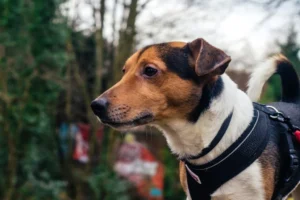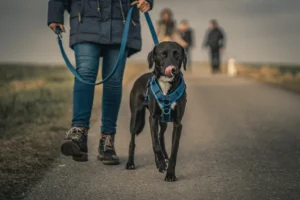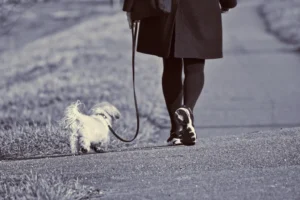Walking your dog shouldn’t feel like you’re being dragged through the trenches, yet here we are, arm outstretched, trying not to trip over our four-legged drill sergeants. Remember, your walk in the park shouldn’t feel like a walk of shame.
By the end of this post, you’ll have grasped the essentials of teaching your dog to heel with turns and changes of pace, turning those chaotic walks into harmonious strolls.
Key takeaways:
- Equip yourself with a no-pull harness and double-ended leash for better control during heeling training.
- Reward your dog with high-value treats at knee level to keep them focused on heeling by your side.
- Practice heeling with turns and pace changes in distraction-free environments before taking these skills into busier areas.
What is Heeling, Exactly?
When we talk about heeling, we’re diving into the world of controlled, disciplined walks with your furry best friend firmly by your side.
It’s not about turning your daily walks into boot camp drills, but rather about teaching your dog to respect your pace, stay focused, and move in harmony with you. Whether you’re strolling along a bustling city sidewalk or navigating your way through a serene park, heeling ensures your dog isn’t darting ahead or dragging their paws behind. It’s the sweet spot of leash walking that every dog owner dreams of.
Why is Teaching Heeling Important?
You might wonder why you should invest time in teaching your dog to heel, especially if your walks are currently more chaotic than calm. The truth is, the benefits of heeling extend far beyond just having more orderly walks. Here are a few reasons why it’s a game-changer:
- Safety Comes First: Keeping your dog close prevents them from lunging at cars, other dogs, or pedestrians, reducing the risk of accidents and confrontations.
- Obedience Is Key: Heeling is a foundational obedience skill that reinforces your role as the pack leader. It sets the stage for teaching other commands and behaviors.
- Bonding Time: Mastering heeling together strengthens your connection with your dog. It’s a team effort that builds trust and understanding, as you learn to read each other’s cues and body language.
In essence, teaching your dog to heel makes walks enjoyable for both of you, facilitating a peaceful coexistence that’s rooted in mutual respect and understanding.
How Do You Start Training Your Dog to Heel?
Embarking on the journey of heeling training can seem daunting at first, but with the right approach, it’s entirely achievable. Let’s get you started on the right foot (or paw):
-
Choose the Right Gear: Opt for a sturdy, comfortable leash and collar. A six-foot leash offers enough flexibility, while a fitted collar ensures safety without causing discomfort. One highly recommended combo for training sessions is the Freedom No-Pull Harness along with a double-ended leash for better control.
-
Find a Distraction-Free Zone: Begin in a quiet, familiar environment where your dog feels at ease. This could be your backyard or a seldom-used part of a local park.
-
Use Treats Wisely: Keep some high-value treats handy, like small pieces of chicken or cheese, to reward your dog for staying by your side. The trick is to reward them at your knee level (where you want them to focus) instead of making them jump up to your hand.
-
Start with the Basics: Before you dive into turns and changes of pace, get your dog comfortable with walking beside you. Use a consistent cue word like “heel” and reward them when they comply. Practice for short stints, keeping sessions fun and ending on a positive note.
-
Introduce Variety Gradually: Once your dog has mastered walking straight by your side, start incorporating slow turns and changes in pace. For turns, guide your dog gently in the new direction and reward them for following suit. For pace changes, use verbal cues like “slow” or “fast” and adjust your movement accordingly, rewarding your dog for matching your speed.
The key to success lies in patience, consistency, and positive reinforcement. Remember, every dog learns at their own pace, so celebrate the small victories along the way.
What sets this approach apart? The emphasis on using high-value treats at your knee level is a game-changer. It’s a simple yet incredibly effective method that encourages your dog to focus on staying by your side, rather than getting distracted by their surroundings. This unique tip, often overlooked, can significantly expedite the learning process and enhance the effectiveness of heeling training.
As you progress, you’ll find that teaching your dog to heel with turns and changes of pace not only improves your walks but also enriches your bond and mutual respect. Stay tuned as we continue to explore more about nurturing the perfect walking partner in our furry friends.
Mastering Turns with Your Dog
Turning with your dog without losing the heeling position can seem like teaching a fish to bike – unlikely but not impossible. The secret sauce? Gradual progression and heaps of patience. Let’s dive straight into the “how-to.”
Start Small: Initiate with 90-degree turns. These are manageable and less likely to confuse your dog. Use a treat to lure them into the turn, making sure their shoulder is aligned with your leg.
Upping the Ante: Once your dog gets the hang of the basic turns, introduce more challenging ones such as U-turns and 360 degrees. Remember, the goal is for your dog to stick to your side like glue, so keep those treats handy for guidance and rewards.
The Ace up Your Sleeve: Here’s a piece of advice you won’t find just anywhere. To master turning, practice in front of a mirror. Yes, you read that right. It helps you see what your dog is doing in real-time, making corrections easier and training more effective.
Consistency Is Key: Practice in various environments – indoors, in your yard, and during walks. Different settings bring different distractions, and overcoming these together strengthens your dog’s attention to your commands.
Adjusting to Different Paces
Changing the pace is not just about physical exercise; it’s about mental agility for your furry companion. The trick is to make it fun and rewarding.
Start at Home: Begin by walking around your house. Change from a slow to a brisk pace and back again. Use a command like “slow” or “fast” to signal the change.
Rewards for Attention: At each pace change, if your dog keeps up, offer a treat. This not only reinforces the behavior but also keeps their focus locked on you amidst distractions.
Real-World Practice: Take this exercise outside. Start in an area with minimal distractions before moving to busier places. The real proof of the pudding is when your dog can heel at different paces, no matter what’s happening around them.
Putting It All Together
Once you’ve tackled heeling, turning, and pace changes separately, it’s time to blend these elements into seamless, enjoyable walks. Here’s how to make it happen:
-
Start Simple: Begin with short sessions combining turns and pace changes. Reward generously for every step done right.
-
Create Challenges: Gradually introduce more distractions – from other pets to bustling parks. The goal is to have your dog focus on you regardless of what’s happening around them.
-
Routine Matters: Consistency is your best friend. Make these practices a regular part of your walks. It will not only reinforce training but also turn these walks into a bonding experience.
-
Patience, Patience, Patience: Remember, Rome wasn’t built in a day. Some days will be better than others. Praise the effort, not just the perfection.
-
Celebrate the Milestones: Getting it right should bring joy to both you and your dog. Celebrate the wins, no matter how small. It’s about the journey just as much as the destination.
Remember, every dog learns at their own pace. The beauty of training lies in strengthening your bond and understanding each other better. So, enjoy these training moments, and let them bring you closer. Happy training!
Alex, a passionate animal lover, has experience in training and understanding animal behavior. As a proud pet parent to two dogs and three cats, he founded AnimalReport.net to share insights from animal experts and expand his knowledge of the animal kingdom.





